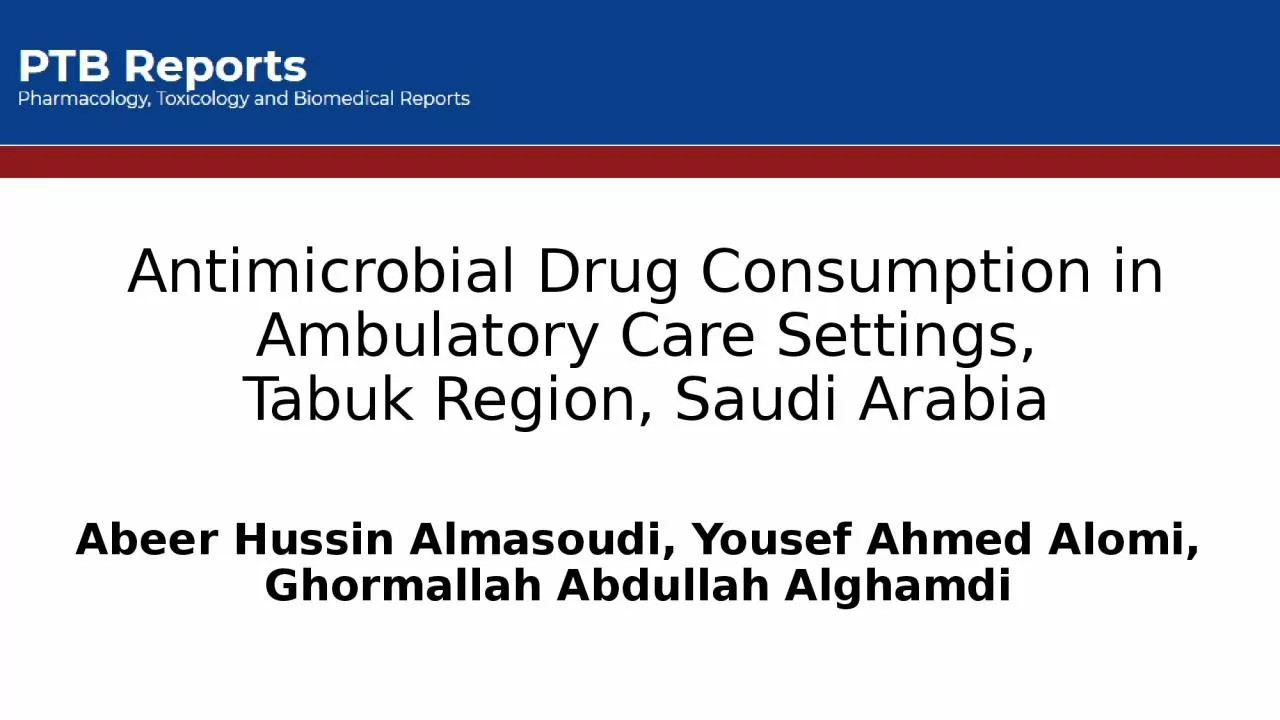

Tabuk Region Saudi Arabia Abeer Hussin Almasoudi Yousef Ahmed Alomi Ghormallah Abdullah Alghamdi Objectives During the 21st century Antimicrobial Resistance AMR has emerged as one of the principal public health problems worldwide In the coming 20 years health car ID: 1006569
Download Presentation The PPT/PDF document "Antimicrobial Drug Consumption in Ambula..." is the property of its rightful owner. Permission is granted to download and print the materials on this web site for personal, non-commercial use only, and to display it on your personal computer provided you do not modify the materials and that you retain all copyright notices contained in the materials. By downloading content from our website, you accept the terms of this agreement.
1. Antimicrobial Drug Consumption in Ambulatory Care Settings,Tabuk Region, Saudi ArabiaAbeer Hussin Almasoudi, Yousef Ahmed Alomi, Ghormallah Abdullah Alghamdi
2. Objectives: During the 21st century, Antimicrobial Resistance (AMR) has emerged as one of the principal public health problems worldwide. In the coming 20 years, health care systems may be incapable to treat bacterial diseases proficiently due to this miracle. We analyzed data from the North West Region Hospitals, Ministry of Health, Saudi Arabia to determine the level of knowledge regarding drug consumption among patients attending five hospitals in ambulatory care settings. Methods: This cross-sectional study was conducted at North West Region Hospitals in Tabuk city, Saudi Arabia for 9 months. The study contestants were selected from different outpatient departments. National Antimicrobial stewardship program highly demand at our country because of poor insight of antibiotics and misappropriation of antibiotics and poor adherence of antibiotics guidelines. Antibiotic consumption is driven from pharmacy database and calculated based on stranded unit of antimicrobial per each hospital. The total cost expenditure of antimicrobial drug consumption was calculated by Ministry of Health National Cost database. The predictable cost expressed in USD. All data and variables analyzed by Microsoft Excel program version 10.
3. Results: The number of antimicrobial drug consumption in ambulatory care settings in the Saudi Arabia were 25,116 i.e. average 5,023.2 per hospital respectively. The highest drug consumption at all ambulatory care visits were azithromycin tablet (10,932), followed by azithromycin syrup (7,760) and moxifloxacin tablet (3218). The overall antimicrobial consumption was 37,620.12 USD and 7,524.02 USD per each hospital. The overall cost medication consumption were adults ambulatory care departments 69.42% (26,114.79 USD), followed by pediatrics ambulatory care departments 24.52% (9,226.018 USD) and neonates ambulatory care departments 6.06% (2,279.32 USD). The highest medication cost was very broad-spectrum antibiotics like Levofloxacin, Linezolid PO IV and Moxifloxacin PO. It disbursed more than 50% of the cost burden.
4. Conclusion: Our results exposed a very high obliviousness of antimicrobial drug consumption and its contributing factors among the study contestants. Ambulatory care settings had a high consumption of antimicrobial drugs with burden cost. Thus, health education and responsiveness are highly and instantly suggested to address antimicrobial drug consumption and related resistances in the Tabuk area at ambulatory care settings. Antimicrobial stewardship program at Ambulatory care clinics is necessary to prevent bugs related resistance, improve patient outcome and avoid unnecessary cost on hospitals in Saudi Arabia.
5. KEYWORDS Antimicrobial, Ambulatory care clinics,Consumption,Hospitals,North West (Tabuk),Saudi Arabia.
6.
7. Our results exposed a very high obliviousness of antimicrobial drug consumption and its contributing factors among the study contestants. Ambulatory care settings had a high consumption of antimicrobial drugs with burden cost. Thus, health education and responsiveness are highly and instantly suggested to address antimicrobial usage in the Tabuk area at ambulatory care settings. In addition, the healthcare providers including pharmacist in all hospitals must also play a role in providing information to their patients so that they can assume positive actions regarding the careful use of antibiotics. The antibiotic stewardship program at ambulatory care services is highly recommended in the district. Further studies are demanding to follow up on the annual antibiotics utilization in the ambulatory care practice.